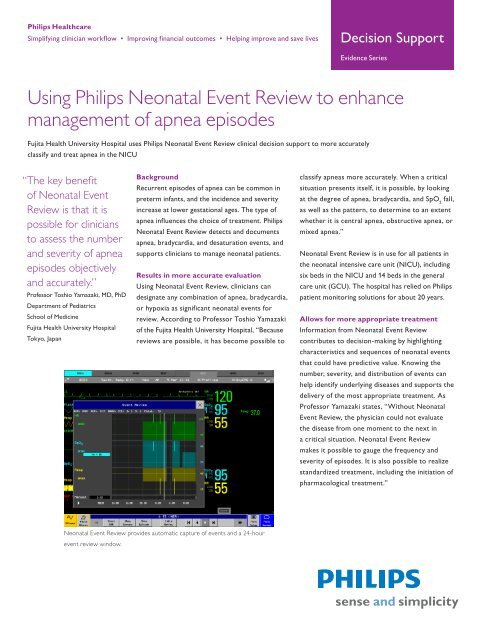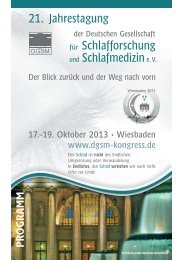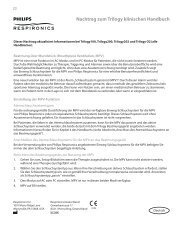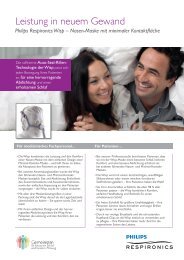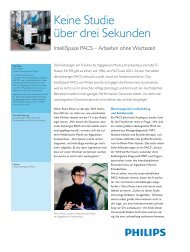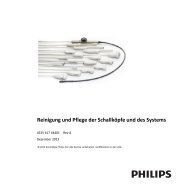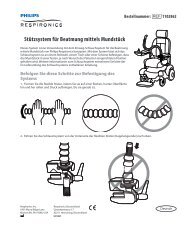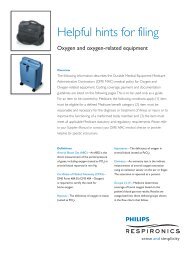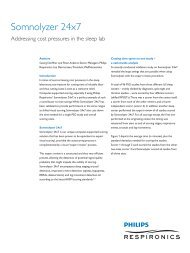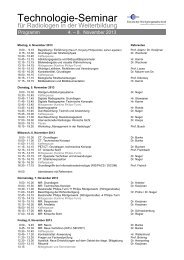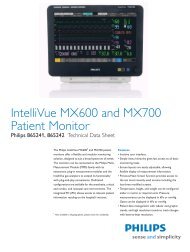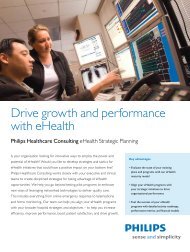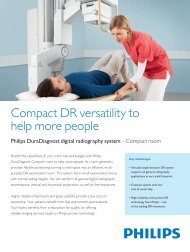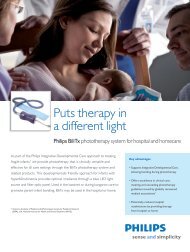Using Philips Neonatal Event Review to enhance management of ...
Using Philips Neonatal Event Review to enhance management of ...
Using Philips Neonatal Event Review to enhance management of ...
Create successful ePaper yourself
Turn your PDF publications into a flip-book with our unique Google optimized e-Paper software.
<strong>Philips</strong> Healthcare<br />
Simplifying clinician workflow • Improving financial outcomes • Helping improve and save lives<br />
Background<br />
Recurrent episodes <strong>of</strong> apnea can be common in<br />
preterm infants, and the incidence and severity<br />
increase at lower gestational ages. The type <strong>of</strong><br />
apnea influences the choice <strong>of</strong> treatment. <strong>Philips</strong><br />
<strong>Neonatal</strong> <strong>Event</strong> <strong>Review</strong> detects and documents<br />
apnea, bradycardia, and desaturation events, and<br />
supports clinicians <strong>to</strong> manage neonatal patients.<br />
Results in more accurate evaluation<br />
<strong>Using</strong> <strong>Neonatal</strong> <strong>Event</strong> <strong>Review</strong>, clinicians can<br />
designate any combination <strong>of</strong> apnea, bradycardia,<br />
or hypoxia as significant neonatal events for<br />
review. According <strong>to</strong> Pr<strong>of</strong>essor Toshio Yamazaki<br />
<strong>of</strong> the Fujita Health University Hospital, “Because<br />
reviews are possible, it has become possible <strong>to</strong><br />
Decision Support<br />
Evidence Series<br />
<strong>Using</strong> <strong>Philips</strong> <strong>Neonatal</strong> <strong>Event</strong> <strong>Review</strong> <strong>to</strong> <strong>enhance</strong><br />
<strong>management</strong> <strong>of</strong> apnea episodes<br />
Fujita Health University Hospital uses <strong>Philips</strong> <strong>Neonatal</strong> <strong>Event</strong> <strong>Review</strong> clinical decision support <strong>to</strong> more accurately<br />
classify and treat apnea in the NICU<br />
“The key benefit<br />
<strong>of</strong> <strong>Neonatal</strong> <strong>Event</strong><br />
<strong>Review</strong> is that it is<br />
possible for clinicians<br />
<strong>to</strong> assess the number<br />
and severity <strong>of</strong> apnea<br />
episodes objectively<br />
and accurately.”<br />
Pr<strong>of</strong>essor Toshio Yamazaki, MD, PhD<br />
Department <strong>of</strong> Pediatrics<br />
School <strong>of</strong> Medicine<br />
Fujita Health University Hospital<br />
Tokyo, Japan<br />
<strong>Neonatal</strong> <strong>Event</strong> <strong>Review</strong> provides au<strong>to</strong>matic capture <strong>of</strong> events and a 24-hour<br />
event review window.<br />
classify apneas more accurately. When a critical<br />
situation presents itself, it is possible, by looking<br />
at the degree <strong>of</strong> apnea, bradycardia, and SpO 2 fall,<br />
as well as the pattern, <strong>to</strong> determine <strong>to</strong> an extent<br />
whether it is central apnea, obstructive apnea, or<br />
mixed apnea.”<br />
<strong>Neonatal</strong> <strong>Event</strong> <strong>Review</strong> is in use for all patients in<br />
the neonatal intensive care unit (NICU), including<br />
six beds in the NICU and 14 beds in the general<br />
care unit (GCU). The hospital has relied on <strong>Philips</strong><br />
patient moni<strong>to</strong>ring solutions for about 20 years.<br />
Allows for more appropriate treatment<br />
Information from <strong>Neonatal</strong> <strong>Event</strong> <strong>Review</strong><br />
contributes <strong>to</strong> decision-making by highlighting<br />
characteristics and sequences <strong>of</strong> neonatal events<br />
that could have predictive value. Knowing the<br />
number, severity, and distribution <strong>of</strong> events can<br />
help identify underlying diseases and supports the<br />
delivery <strong>of</strong> the most appropriate treatment. As<br />
Pr<strong>of</strong>essor Yamazaki states, “Without <strong>Neonatal</strong><br />
<strong>Event</strong> <strong>Review</strong>, the physician could not evaluate<br />
the disease from one moment <strong>to</strong> the next in<br />
a critical situation. <strong>Neonatal</strong> <strong>Event</strong> <strong>Review</strong><br />
makes it possible <strong>to</strong> gauge the frequency and<br />
severity <strong>of</strong> episodes. It is also possible <strong>to</strong> realize<br />
standardized treatment, including the initiation <strong>of</strong><br />
pharmacological treatment.”
Key results<br />
• Provides objective and reliable data about apnea<br />
episodes in neonate<br />
• Allows for appropriate evaluation and treatment <strong>of</strong><br />
apnea episodes<br />
Advantages for clinical research<br />
In addition <strong>to</strong> his clinical practice, Pr<strong>of</strong>essor Yamazaki<br />
has served as principal investiga<strong>to</strong>r in multi-year, multi-<br />
center research trials that included the use <strong>of</strong> <strong>Neonatal</strong><br />
<strong>Event</strong> <strong>Review</strong>, valuable for its uniform standards.<br />
“To measure drug efficacy, it is necessary <strong>to</strong> measure<br />
the frequency and severity <strong>of</strong> apnea episodes. By<br />
using <strong>Neonatal</strong> <strong>Event</strong> <strong>Review</strong>, it was possible <strong>to</strong> get<br />
objective and highly reliable data. I used <strong>Neonatal</strong><br />
<strong>Event</strong> <strong>Review</strong> <strong>to</strong> standardize event criteria for apnea<br />
episodes, target patient selection, and evaluate drug<br />
efficacy,” he reports.<br />
More informed treatment decisions<br />
Clinicians check the daily summaries at the start <strong>of</strong> each<br />
day, and also during shift handovers. The objectivity <strong>of</strong><br />
the data is a key benefit. As Pr<strong>of</strong>essor Yamazaki explains,<br />
“Before the introduction <strong>of</strong> <strong>Neonatal</strong> <strong>Event</strong> <strong>Review</strong>,<br />
we relied on nurse records, but with <strong>Neonatal</strong> <strong>Event</strong><br />
<strong>Review</strong> it has become possible for physicians <strong>to</strong> check on<br />
their own, allowing more accurate evaluation <strong>of</strong> apnea<br />
episodes. Benefits derived from this include the ability<br />
<strong>to</strong> intervene more appropriately and <strong>to</strong> avoid providing<br />
unnecessary treatment.” Teams also find the data from<br />
<strong>Neonatal</strong> <strong>Event</strong> review helpful in educating staff new <strong>to</strong><br />
the NICU.<br />
Please visit www.philips.com/evidence<br />
© 2010 Koninklijke <strong>Philips</strong> Electronics N.V.<br />
All rights are reserved.<br />
Aids efficiency<br />
<strong>Philips</strong> Healthcare reserves the right <strong>to</strong> make changes in specifications and/<br />
or <strong>to</strong> discontinue any product at any time without notice or obligation<br />
and will not be liable for any consequences resulting from the use <strong>of</strong> this<br />
publication.<br />
<strong>Neonatal</strong> <strong>Event</strong> <strong>Review</strong> contributes <strong>to</strong> overall efficiency<br />
by au<strong>to</strong>mating the documentation <strong>of</strong> up <strong>to</strong> 50 events<br />
over a 24-hour period, saving time and helping <strong>to</strong> reduce<br />
errors associated with manual documentation.<br />
Background<br />
Fujita Health University Hospital is one <strong>of</strong> Japan’s largest<br />
hospitals, with a staff <strong>of</strong> about 2,000 as well as 1,505<br />
inpatient beds, and an average <strong>of</strong> 2,000 outpatients each<br />
day. The hospital plays a vital role in advanced medicine<br />
as a facility supporting research in<strong>to</strong> sophisticated<br />
medical treatments, the development and evaluation<br />
<strong>of</strong> new medical technologies, and providing high-level<br />
diagnoses and treatment <strong>to</strong> patients.<br />
The Fujita Health University Hospital School <strong>of</strong> Medicine in Tokyo, Japan.<br />
<strong>Philips</strong> Healthcare is part <strong>of</strong> Royal <strong>Philips</strong> Electronics<br />
www.philips.com/healthcare<br />
healthcare@philips.com<br />
Printed in The Netherlands<br />
4522 962 61811 * MAY 2010


